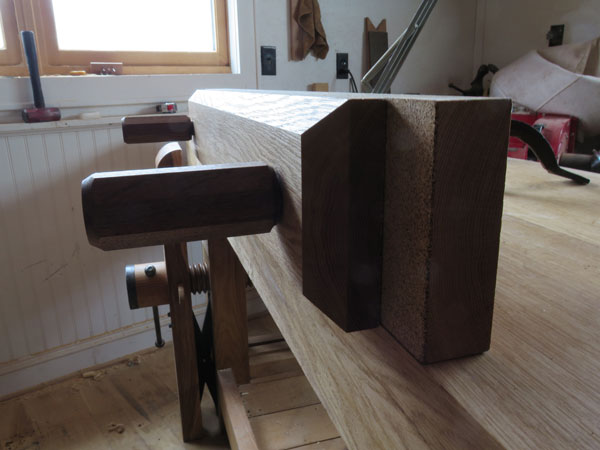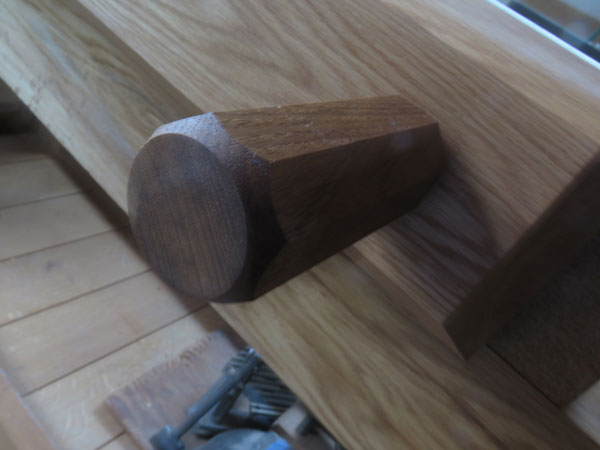We may receive a commission when you use our affiliate links. However, this does not impact our recommendations.
Since I began making Moxon-style vises in 2010, I’m made several dozens for students customers and have made some small changes to the way I build them.
Above all, I try to keep my Moxon vises as simple and compact as possible, which is why I haven’t added tables or other gizmos. Here is what my latest one, which ships out today, looks like.
The most significant change is that I now bevel all four edges of the front chop, as shown above. This reduces weight without changing the clamping pressure applied by the screws (clamping pressure radiates from 45° from the pressure point).
Why reduce the weight? To shift the balance of the vise onto the bench. The vise shown above sits with the rear chop on the benchtop without tipping forward. That makes it easier to clamp the vise down with only two hands. The bevel on the edges also makes it easier to saw the pins in half-blind dovetails without the saw encountering the chop.
The second change is that I line both jaws with adhesive cork instead of leather. Cork is inexpensive, easy to install and I can plane and bore it like wood. I like to have the cork cover the entire surfaces of both chops so I can clamp outside the screws. This is helpful for when sawing the half pin off the tailboard in casework. With the cork I can get a lot of pressure both inside and outside the screws.
The handles are also a little different. After so many disasters with the Chinese wood-threading kits I buckled down and bought a 28mm German one from Dieter Schmid. Yes, it’s expensive, but this thing has paid for itself many times over already. (Note: I also had to buy a 23mm Forstner for the pilot hole.)
Another change to the handles: I now use teak offcuts whenever possible. Teak is ideal for this part. It is tough and is naturally waxy. These are a joy to work with no squeaking.
The final change is mostly cosmetic. I now add a few die-forged French nails to attach the cleat to the back of the rear chop – in addition to gluing the cleat. I just like the way it looks.
The Moxon vise is still one of my most-used shop appliances. My back thanks me for the vise every time I have to cut dovetails for casework or drawers.
— Christopher Schwarz
Here are some supplies and tools we find essential in our everyday work around the shop. We may receive a commission from sales referred by our links; however, we have carefully selected these products for their usefulness and quality.













Chris:
Arey ou going to have an instructional DVD on making this vise, or perhaps include the plans in a new book?
What no lambs tongues!
Great looking vise. I noticed the handles don’t have cranks. Do you get enough torque tightening these by hand?
I do understand paying for quality and I can see Chris paying that kind of money for the tap and die. But for someone like me who would only make maybe 5 or 6 of these in several years. Is there a cheaper version available that would still work pretty good?
OK….I’ll ask the obvious question…..why not bevel the top of the back piece as well?
I use a Moxon vice from the Robert Wearing Jig and Fixture book. A couple of chunks of leftover 2x stock, a couple of threaded inserts, some all-thread, thrust washers, and a couple of tool handles, pretty much stuff I had lying around so effectively free.
What dimensions have you found most useful for your vise? Do you keep a long one around for casework, and a shorter one for narrower stock?
The Dieter Schmidt tap and die is certainly something. Said this before. I am thrifty Jennie and the price is scary if you don’t have one already. So I will say it again. Mine is stamped West Gemany and it is still functioning perfectly. Beware , Company literature suggests soaking the thread stock in water before threading. Yuk. There goes dimension, here comes cutter rust. Use tallow.
Would like to drop the term Moxon Vise. It isn’t. Moxon himself called it the “double bench screw” , a wonderfully apt term.
Thrifty jennie cobbled up a double bench screw for under $50. You don’t need the the Dieter Schmidt tap and die. Chris has the two of them that Mike Siemsen kindly made for us – the dovetailer’s biggie and the modest chairmaker’s version. Chris, please send me the baby and test the biggie. They aren’t mellow and traditional but what a price. I would like to hear from Chris if he think’s they work.
I know it wasn’t the priority but that simple bevel really makes the vise stand-out aesthetically.
(and yes, I’m all for beautiful tools and appliances in the shop. We love wood, we love craftsmanship. Why not surround ourselves with it in the shop when possible and not impractical)